5901 Botham Jean Blvd, Dallas, TX 75215
Scrap Shear Machine Process: How Modern Shears Improve Metal Recycling Efficiency
October 9, 2025The scrap shear machine process is a crucial initial step in modern metal recycling operations. This process employs powerful hydraulic equipment designed to cut and compress large, unwieldy pieces of scrap metal into smaller, more manageable sizes. Picture it as industrial-strength scissors capable of slicing through thick steel effortlessly.
These robust machines have become indispensable in metal recycling facilities, scrap yards, steel works, and foundries worldwide. They efficiently process everything from light sheet metal to heavy industrial scrap that would otherwise be difficult to transport or melt down. The guillotine-like cutting action is powered by immense hydraulic force, often exceeding 1,000 tons of pressure in larger models.
Beyond merely reducing size, scrap shear machines also increase material density through compression, making the processed scrap more economical to transport and easier for subsequent recycling processes. Transforming bulky waste metal into uniform, dense pieces is a foundational element in the circular economy of metals, allowing valuable resources to be efficiently recovered and reused rather than discarded.
How Do Scrap Shear Machines Work?
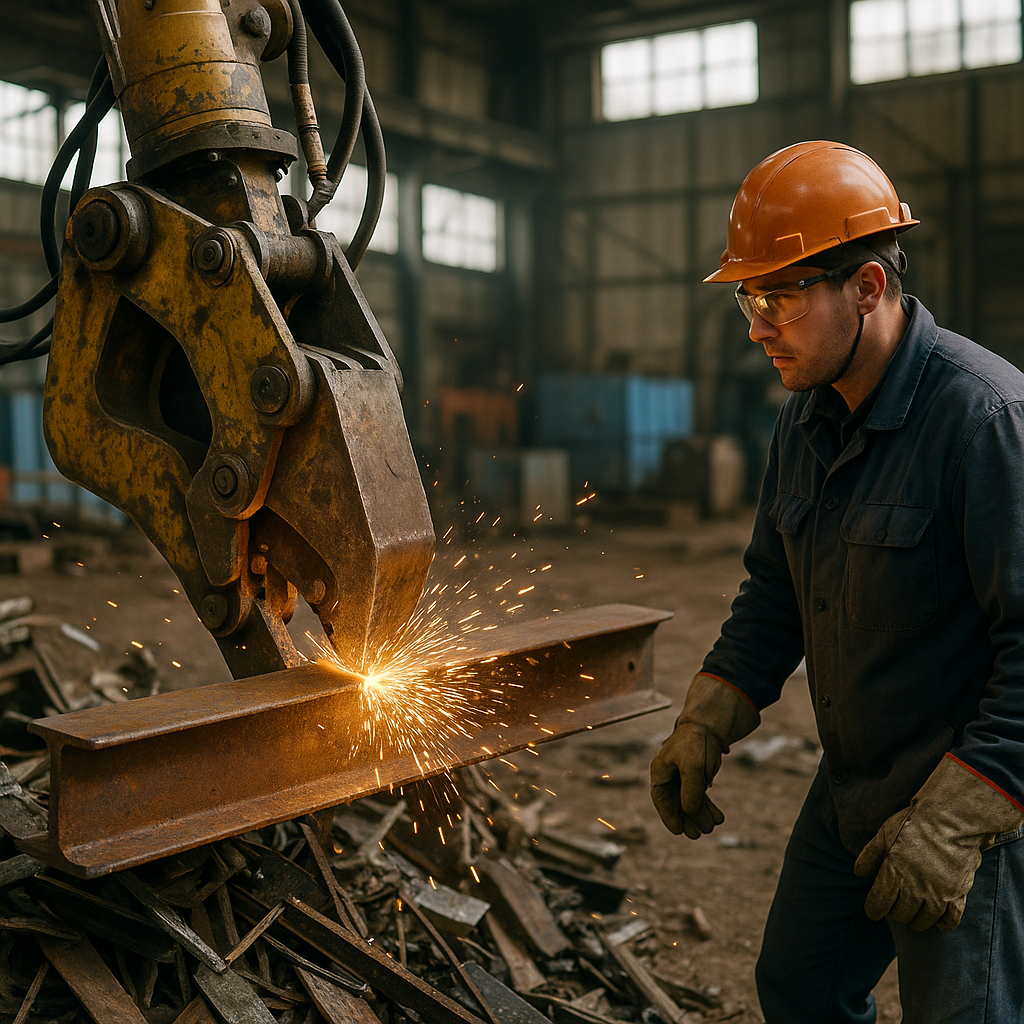
Scrap shear machines operate through a precisely engineered guillotine system powered by hydraulic energy. These powerful recycling tools transform bulky metal scrap into manageable pieces through a controlled cutting process.
Cutting begins when hydraulic fluid, pressurized by a pump, creates the force needed to move the cutting blade. This system converts fluid pressure into mechanical energy, similar to how water pressure drives a turbine. The pressurized fluid pushes against a piston inside a cylinder, generating forces capable of slicing through thick steel with precision.
Specialized cutting knives are at the core of these machines. The upper blade descends against a fixed lower blade, creating a shearing action that separates the metal cleanly. The force applied is significant enough to cut even thick industrial metals without melting or excessive deformation, preserving the metal for recycling.
Modern scrap shear machines often feature angled blades set between 80-90 degrees. This angle reduces the cutting force required compared to straight blades. Like a chef slicing at an angle rather than straight down, these blades create a progressive cut that improves efficiency and reduces wear on the machine components.
Scrap shear machines are remarkably versatile, processing heavy materials like automotive frames and structural steel, as well as lighter scrap like sheet metal and wire. This adaptability is crucial in recycling operations. As material is cut, it becomes more compact, increasing density while reducing physical dimensions, making scrap metal more economical to transport and process further.
The cutting cycle repeats as new material is fed into the machine, with hydraulic controls ensuring consistent application of force for clean, precise cuts. The machine’s frame and structure are engineered to withstand the extreme forces involved, ensuring stability and reliability in demanding environments.
| Angle Range (Degrees) | Features | Best For | Real-World Examples |
|---|---|---|---|
| 10-15° | Extremely sharp but less durable | Precision cut | Sushi preparation, fruit carving |
| 15-20° | Sharp and versatile | Daily kitchen tasks | Vegetable prep, meat slicing |
| 20-25° | Balanced sharpness and durability | Heavy-duty work | Breaking down poultry, chopping herbs |
| 25-30° | Highly durable, less sharp | Outdoor tasks | Camping, bushcraft |
Most scrap shear machines include features such as material hold-downs to secure the scrap during cutting, preventing movement that could affect cut quality or pose safety risks. Advanced models often incorporate automated feeding systems and programmable controls that optimize cutting sequences based on material type and size, enhancing productivity in busy recycling operations.
What Are the Different Types of Scrap Shear Machines?
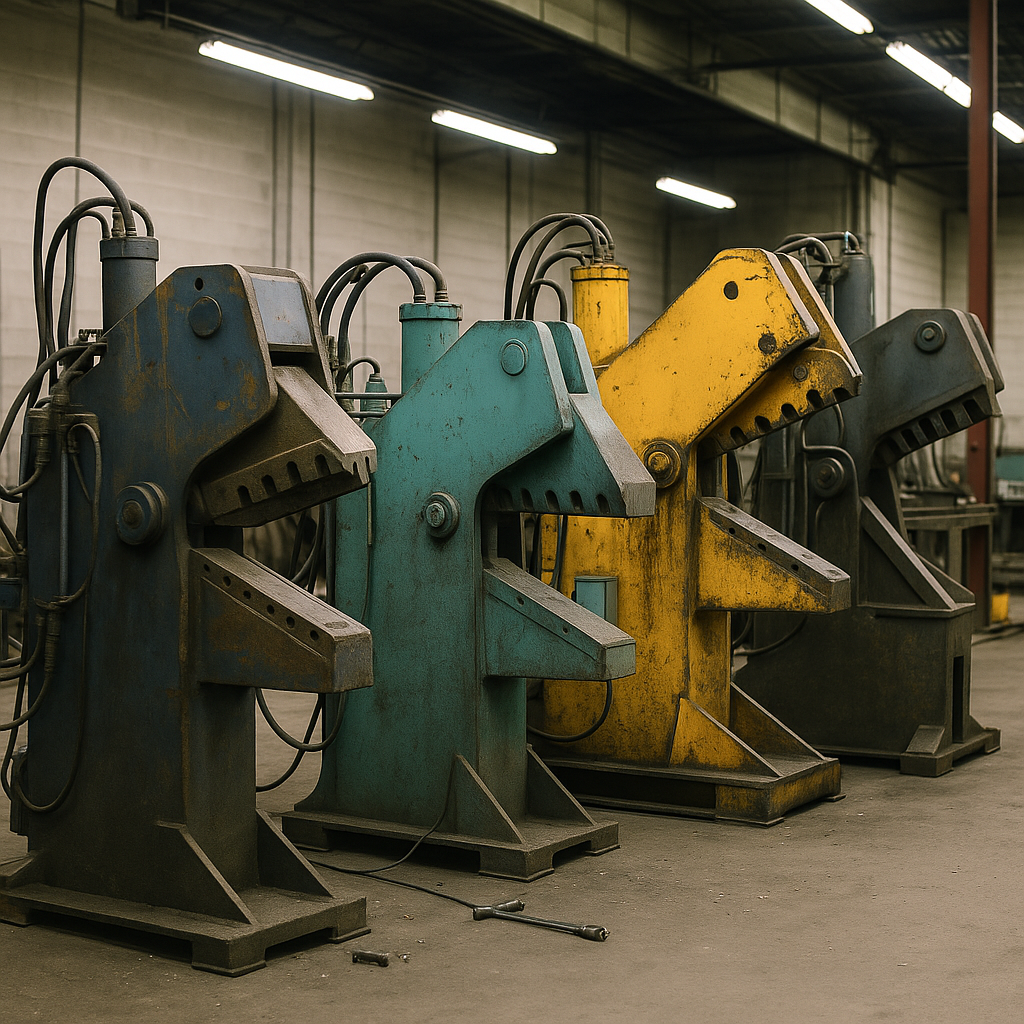
The scrap recycling industry relies on specialized equipment to process various metal materials efficiently. Scrap shear machines are available in distinct types, each designed for specific applications and materials. Understanding these machines helps recycling operations select the right equipment for their needs.
Scrap shears operate with a guillotine-like cutting mechanism powered by hydraulic energy. The cutting force, blade design, and feed system differ among models to accommodate a range of scrap metals, from light to heavy and bulky materials.
Compact Shears
Compact shears feature a horizontal design that complements traditional shearing operations. These machines are ideal for facilities with space constraints but still require effective metal processing. Compact shears excel at processing specific scrap types in controlled volumes.
Their streamlined design makes compact shears suitable for operations where space efficiency is paramount without sacrificing cutting performance.
Press-Wing Shears (CIV)
Press-wing shears are engineered for versatility in processing lightweight to medium-weight scrap metals. These machines have wing-type compression boxes that enhance material density before cutting, effectively managing materials of varying weights and densities.
The CIV line of shear-balers can process up to 50 tons per hour, suitable for medium-capacity operations. They deliver excellent densification while maintaining accurate cut lengths, resulting in high-quality finished products that meet industry standards.
Inclined Shears (CIC)
Inclined shears utilize gravity to enhance feeding efficiency. Their angled design allows scrap to be fed continuously, making these machines well-suited for processing lengthy materials requiring high densification and production capacity.
The inclined configuration enables automatic and continuous operation, significantly reducing labor needs. These machines are preferred in operations where long metal pieces need consistent processing with minimal operator intervention, offering high efficiency for high-volume processing environments.
Side Pre-Compression Shears (CIB)
Side pre-compression shears represent heavy-duty scrap processing equipment. Designed for handling heavy and bulky scrap metal, these robust machines apply side compression to densify material before cutting.
The CIB line can manage up to 98 tons per hour, making them suitable for large-scale operations with significant throughput requirements. Their powerful compression systems ensure that even the most challenging scrap materials are uniformly densified before cutting, producing high-density output.
LINDEMANN EtaCut II Heavy-Duty Shears
The LINDEMANN EtaCut II represents the latest generation of energy-efficient heavy-duty scrap shears. These machines deliver excellent cutting force while optimizing energy consumption, ideal for operations balancing performance with reduced operating costs.
The EtaCut II series is built for durability in demanding environments like scrap yards, steel works, and foundries. Their robust construction ensures reliable performance with challenging materials, while efficiency features help manage long-term operational expenses.
NxtCut Series Medium-Capacity Shears
The LINDEMANN NxtCut series is specifically engineered for medium production volumes. These machines process scrap metal with minimal energy consumption and operational costs, making them an economical choice for mid-sized recycling operations.
NxtCut shears balance performance and efficiency for facilities not requiring the highest throughput but still needing reliable, consistent processing power. Their optimized design focuses on reducing energy usage without compromising cutting abilities.
NxtCut WING Enhanced Efficiency Shears
The NxtCut WING represents an advanced iteration of standard scrap shears, featuring a powerful wing-type compression box enhancing processing efficiency. This design elevates productivity and material handling capability.
The wing-type compression system provides superior material densification before cutting, resulting in more consistent output quality and higher throughput. These machines are valuable for operations processing varied scrap types benefiting from pre-compression before shearing.
| Type of Shear | Primary Use | Capacity | Application |
|---|---|---|---|
| Gantry Shear | Cutting large, heavy metals like beams and pipes | High | Industrial scrap yards, heavy-duty cutting |
| Alligator Shear | Cutting smaller metal pieces like rods and bars | Moderate | Recycling facilities, smaller operations |
| Guillotine Shear | Cutting metal sheets, plates, and thicker pieces | High | Fabrication shops, industrial scrap processing |
Each type of scrap shear machine offers specific advantages based on material type, volume requirements, and facility constraints. Technological advancements in these machines continue to improve efficiency, reduce energy consumption, and enhance the quality of processed scrap metals, greatly contributing to more sustainable recycling operations.
What Are the Benefits of Using Scrap Shear Machines?
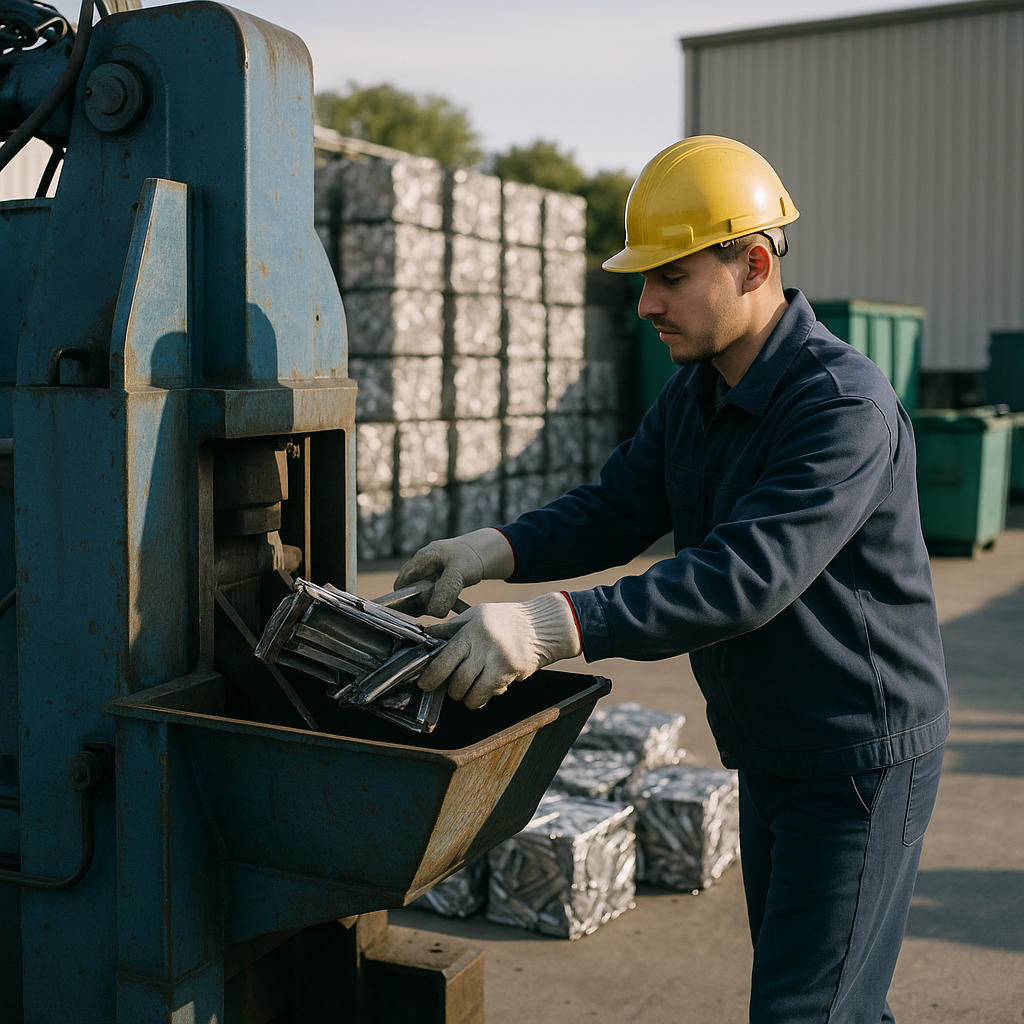
Scrap shear machines offer significant advantages to metal recycling operations through their ability to transform bulky, difficult-to-handle scrap into manageable pieces. These powerful machines are critical components in the recycling process, providing numerous benefits that enhance both operational efficiency and profitability.
Enhanced Processing Speed and Throughput
Scrap shear machines cut through metal quickly and consistently, significantly speeding up the recycling process. Unlike traditional methods that can be labor-intensive and time-consuming, modern hydraulic shears can process large volumes of material rapidly.
This increased speed translates into higher throughput capacity, with some continuous hydraulic shear machines able to process up to 50 tons of mixed and heavy-duty scrap per hour without length restrictions. This capability allows facilities to manage larger material volumes without expanding their workforce.
Advanced shears include automatic operation with continuous material feeding systems, further boosting productivity. These features reduce cycle times between cuts and minimize downtime, keeping operations efficient even during peak periods.
Uniform Material Sizing for Downstream Efficiency
One of the most valuable benefits of scrap shear machines is their ability to produce consistently sized metal pieces. This uniformity greatly enhances downstream processing efficiency across several aspects.
When scrap metal is reduced to uniform sections, it becomes easier to handle, transport, and process through subsequent recycling stages. The consistent sizing allows for more accurate sorting, improving material recovery rates and quality.
Uniformly cut metal also boosts other equipment’s performance in the recycling chain. Properly sized material feeds more efficiently into melting furnaces, shredders, and balers, helping prevent equipment jams and breakdowns that could interrupt production.
For facilities using industrial baling systems, properly sheared metal achieves higher packing density. This increased density directly improves bale quality and stability during transportation, reducing the risk of load shifting and potential safety hazards.
Lower Labor Costs and Improved Safety
Scrap shear machines significantly reduce the need for manual labor in metal processing operations. The automation of cutting processes minimizes worker involvement in handling heavy, unwieldy scrap metal pieces.
This reduction in manual handling offers dual benefits: lower labor costs and enhanced workplace safety. By limiting direct contact with sharp metal edges and heavy materials, recycling facilities can reduce workplace injuries and associated costs like workers’ compensation claims and lost productivity.
Modern shear machines include advanced safety features such as protective guards, emergency stops, and secure material clamping systems, ensuring a safer working environment while maintaining high production levels.
Space Optimization and Transportation Savings
Scrap yards and recycling facilities often face space constraints. Unprocessed metal takes up significant floor space, creating bottlenecks and limiting capacity.
Shear machines address this issue by reducing the volume of stored material. When metal is cut into smaller, uniform pieces, it occupies up to 30% less storage area, allowing facilities to process larger quantities without needing additional space.
The transportation benefits are also significant. Uniformly sized material loads more efficiently onto trucks and shipping containers, maximizing weight capacity while staying within legal load limits. This can reduce transportation costs by up to 20% through fewer shipments and improved fuel economy per ton of material moved.
Integration With Other Recycling Systems
Advanced scrap shear machines can integrate seamlessly with other components in the recycling process. Some models connect directly with balers or material recovery systems, creating efficient processing lines that minimize material handling between steps.
This integration is particularly valuable for high-volume recycling operations where throughput and efficiency are crucial. Integrated systems reduce transition times between processes and often need less operator intervention.
For example, shear-baler combinations incorporate cutting mechanisms that process oversized materials before compressing them into uniform bales in a single operation. This streamlines operations for scrapyards that receive various material types and sizes.
Facilities can further enhance efficiency by incorporating conveyor systems that automatically feed material to and from the shear machine. This continuous material flow maximizes equipment utilization and reduces idle time between processing batches.
Environmental and Economic Benefits
The environmental advantages of using scrap shear machines extend beyond basic recycling. By optimizing the recycling process, these machines help reduce the environmental footprint of metal recovery operations.
More efficient transportation, resulting from properly sized material, means fewer truck miles and lower carbon emissions per ton of recycled material. The improved economics of processed scrap also boost recycling rates by making metal recovery more profitable, diverting additional material from landfills.
From an economic perspective, properly sheared scrap metal typically commands higher market prices. The uniform density and reduced contamination make it more valuable to end processors, potentially increasing revenue by 10-20% compared to unprocessed scrap.
The combination of lower operating costs and higher material value significantly improves profit margins for recycling operations using scrap shear machines, making these devices essential investments for competitive facilities.
How to Choose the Right Scrap Shear Machine
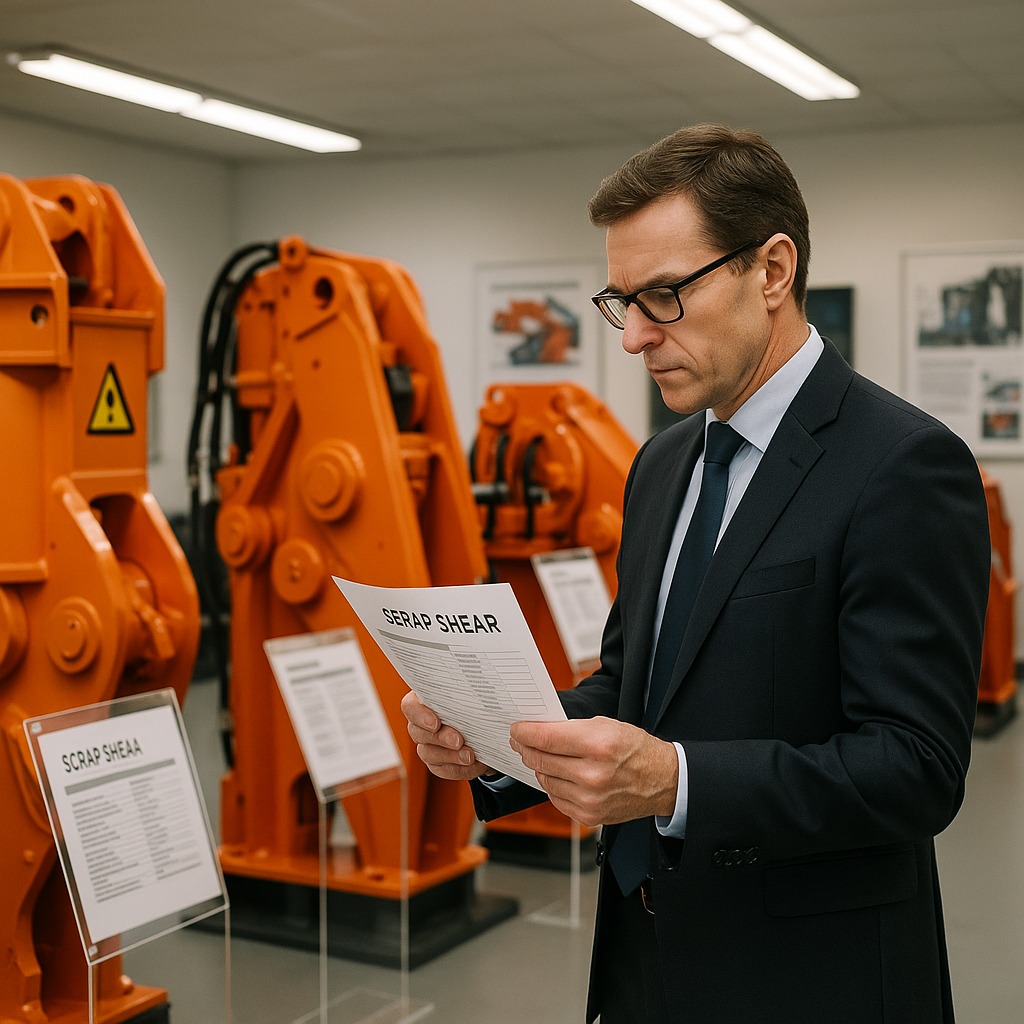
Selecting the appropriate scrap shear machine for your metal recycling operation is a critical decision that impacts operational efficiency, productivity, and long-term costs. With numerous options on the market, such as alligator shears, gantry shears, and guillotine shears, businesses need a structured evaluation approach.
Material Type and Volume Considerations
The first step in selecting a scrap shear machine is analyzing the materials you process. Different metals require varying cutting forces. For bulky, heavy materials like beams and structural steel, a powerful gantry shear with high tonnage is necessary.
Light metals and smaller pieces may be efficiently processed with alligator shears, which offer versatility for varied material sizes. For operations focusing on flat metal sheets and plates, guillotine shears deliver precise, clean cuts with excellent efficiency.
Your current and projected processing volume should dictate machine capacity. A facility processing hundreds of tons daily needs industrial-grade equipment with continuous operation capabilities, while smaller yards may find mid-range machines more cost-effective.
Technical Specifications and Performance
Cutting force, measured in tons, is a crucial technical specification. Heavy-duty applications processing thick metals may require over 800 tons of force, while operations handling thinner materials might only need 200-500 tons. Manufacturers typically provide detailed specifications about the maximum thickness and hardness their machines can handle.
Hourly processing capacity directly impacts operational throughput. Some modern scrap shears can process over 20 tons per hour under optimal conditions. Assess whether the machine’s capacity aligns with your production goals and facility output requirements.
Energy efficiency has become increasingly important as energy costs rise. Hydraulic systems with variable frequency drives and energy recovery systems can reduce power consumption by 15-30% compared to conventional systems, leading to significant savings over the machine’s lifetime.
| Type | Primary Use | Cutting Mechanism | Portability | Cutting Capacity | Precision | Efficiency |
|---|---|---|---|---|---|---|
| Gantry Shear | Cutting large, heavy scrap metal like beams, pipes | Vertical blade moves downwards | Typically stationary | High | Medium | Efficient for large volumes of heavy scrap |
| Alligator Shear | Cutting smaller scrap metal pieces like rods, bars | Hinged blade closes like an alligator’s jaw | Often mobile, can be moved on-site | Moderate | Low | Quick for smaller and medium scrap |
| Guillotine Shear | Cutting metal sheets, plates, and thicker pieces | Straight blade that moves vertically | Usually stationary | High | High | Efficient for cutting metal sheets and plates |
Operational and Integration Factors
Consider how the new machine will integrate with existing recycling systems. The best shear should complement your current setup, creating a smooth workflow from intake to processing. Features like compatible feed systems, output conveyors, and control interfaces enhance operational continuity.
Maintenance requirements vary significantly between machines. Look for designs with accessible wear parts, simplified hydraulic systems, and extended service intervals. Some manufacturers now offer predictive maintenance technology that monitors machine conditions and alerts operators before failures occur.
The physical footprint and installation requirements must match your facility constraints. Gantry shears require significant floor space and often specialized foundations, while more compact alligator shears offer flexibility for facilities with space limitations. Consider ceiling height requirements, especially for machines with vertical cutting mechanisms.
Business and Support Considerations
Total cost of ownership extends beyond the purchase price. Calculate long-term costs including energy consumption, maintenance expenses, wear part replacements, and estimated downtime. Some machines with higher upfront costs may deliver better ROI through increased efficiency and reduced operating costs.
Manufacturer support and parts availability can make or break your operation during critical downtime situations. Evaluate the supplier’s service network, response times, and parts inventory. Leading manufacturers offer comprehensive support packages with remote diagnostics, technical hotlines, and rapid field service.
Safety features should never be compromised. Modern scrap shears include emergency stops, safety guards, two-hand operation requirements, and lockout systems. Some advanced models incorporate proximity sensors and operator presence detection for additional protection.
Decision Checklist for Scrap Shear Selection
When evaluating potential scrap shear machines, use this systematic checklist to ensure all critical factors are considered:
- Material Processing: Identify the types, sizes, and hardness of metals you typically process
- Volume Requirements: Calculate your daily and hourly processing needs, including future growth
- Technical Specifications: Compare cutting force, blade design, and cycle times
- Energy Efficiency: Evaluate hydraulic systems, motor efficiency, and power recovery features
- Integration Capabilities: Assess compatibility with existing systems and facility workflow
- Maintenance Requirements: Compare service intervals, wear part accessibility, and diagnostic features
- Facility Constraints: Measure available space, foundation requirements, and utility needs
- Total Cost Analysis: Calculate purchase price, operating costs, and expected ROI
- Manufacturer Support: Research service network, parts availability, and technical assistance
- Safety Features: Verify compliance with industry standards and operational protections
By methodically evaluating these factors against your specific operational context, you can select a scrap shear machine that not only meets your current requirements but also accommodates future growth. The right machine becomes a valuable asset that enhances your recycling operation’s efficiency, safety, and profitability for years to come.
Conclusion: The Future of Scrap Shear Machine Processes
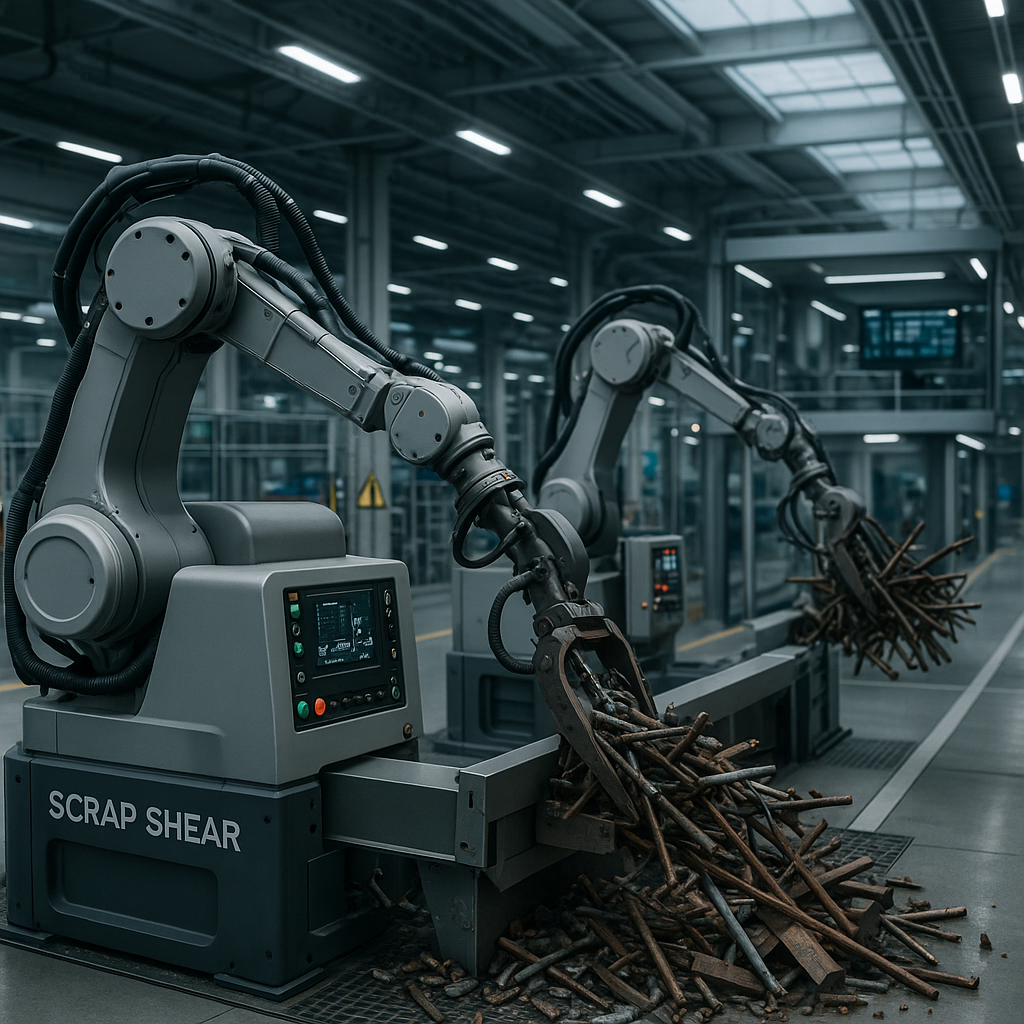
The metal recycling industry is poised for a significant transformation, with scrap shear machine technology at the forefront. These machines now feature advanced automation, improved energy efficiency, and smooth integration with other recycling systems. This progress makes modern scrap shear equipment more powerful, precise, and versatile than earlier models. As recycling facilities handle increasingly complex material streams, these technological advancements come at a critical time for the industry.
Scrap shear machines are a core technology within the circular economy framework. They effectively downsize and prepare reclaimed metal for manufacturing, supporting sustainable production practices across industries. By doing so, scrap shear technology reduces environmental impact by minimizing the need for raw material extraction while conserving energy and resources. For municipalities, businesses, and organizations committed to sustainability, investing in advanced metal recycling infrastructure provides both environmental and economic benefits. To explore how your operation can benefit from state-of-the-art scrap metal processing solutions, contact Okon Recycling at 214-717-4083.
